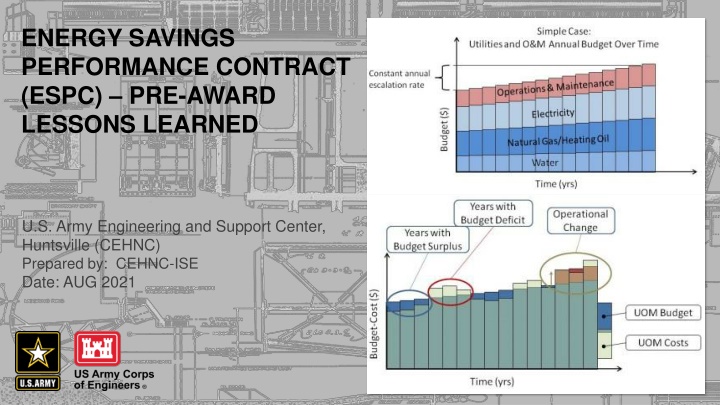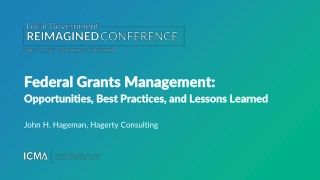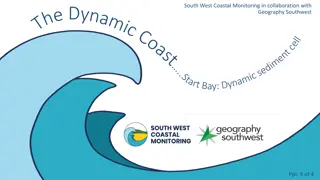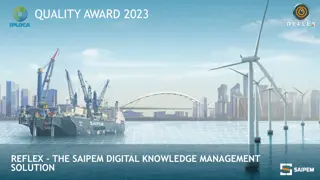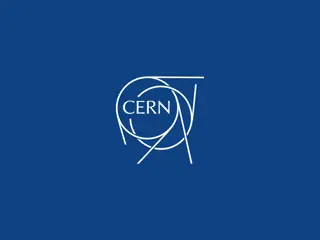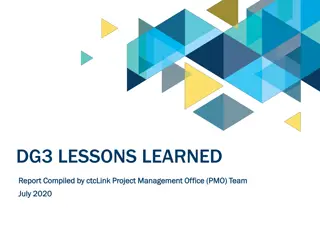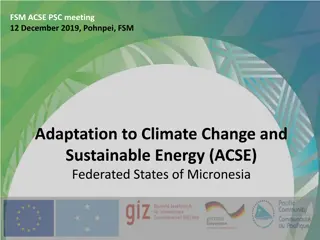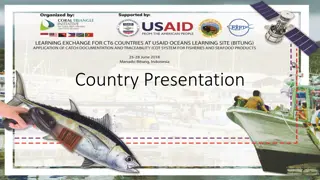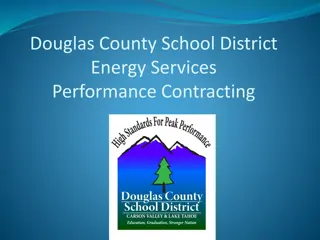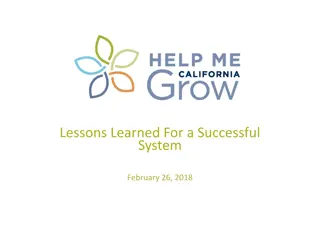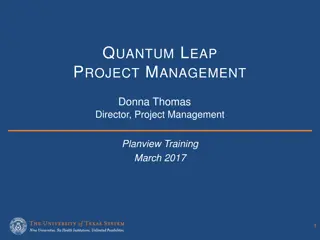ESPC Program Lessons Learned for Effective Project Development
This briefing shares insights from the U.S. Army Engineering and Support Center on Energy Savings Performance Contracts (ESPC), focusing on project engagement and workshop milestones. It discusses key considerations, disadvantages, and best practices to enhance the success of third-party financed projects. The content emphasizes strategic planning, stakeholder involvement, and decision-making to optimize the execution of ESPC initiatives for long-term benefits.
Download Presentation

Please find below an Image/Link to download the presentation.
The content on the website is provided AS IS for your information and personal use only. It may not be sold, licensed, or shared on other websites without obtaining consent from the author.If you encounter any issues during the download, it is possible that the publisher has removed the file from their server.
You are allowed to download the files provided on this website for personal or commercial use, subject to the condition that they are used lawfully. All files are the property of their respective owners.
The content on the website is provided AS IS for your information and personal use only. It may not be sold, licensed, or shared on other websites without obtaining consent from the author.
E N D
Presentation Transcript
ENERGY SAVINGS PERFORMANCE CONTRACT (ESPC) PRE-AWARD LESSONS LEARNED U.S. Army Engineering and Support Center, Huntsville (CEHNC) Prepared by: CEHNC-ISE Date: AUG 2021
2 ESPC PROGRAM BLUF This briefing provides lessons learned to help improve development and execution of 3rd party financed projects for our customers and stakeholders. The CEHNC ESPC program has developed, implemented and managed hundreds of ESPC projects for various DoD agencies through three Multiple Award Task Order Contracts (MATOC s) Serves as the primary Army agency in management of Army ESPC s which are contracts that can have a performance period of up to 25 years. Also manages ESPCs for Air Force, Navy, Marines, and serves as project facilitators for DOE, GSA, Civil Works projects. Program has been audited by AAA, GAO and IG reviews including GAO-15-432, DODIG-2019-058 and implemented recommendations accordingly. Follow: ESPC statutes, regulations, DOE/DOD guidelines, Service specific guidelines for ESPC s, and industry best practices.
3 PROJECT ENGAGEMENT LESSON LEARNED #1 ESPCs are not right for every situation. There are some disadvantages: Financing charges, termination fees, measurement & verification and invoice processing costs increase total cost to the Army ESCO payments are must pay, requiring installations to implement long term planning and budgetary discretion of utility accounts Potential tendency of installation to want to expand scope of ESPC contractor to include base wide non ESPC operations From ESCO to Senior leaders/Stakeholders we must all realize a square peg in a round hole may fit but not meet the mission. ESPC s are a tool in the toolbox. Evaluation of future projects and how they fit within Installation Energy and Water Planning (IEWP s) Ensure a stakeholder and champion exists and understands the process Involve and ensure all parties participate from the beginning and are aware of any deviations to original project boundaries Involve the chain of command and organizational structures; involve ID s, Districts, HQ in the decision-making process. Installations planning a log of changes should exclude those areas from these long term ESPCs
4 WORKSHOPS LESSON LEARNED #2 Workshops are critical milestones and decision points, examples are: Financial Workshop Development of utility and escalation rates used for the life of the project discussed M&V Workshop Proposed M&V methodologies, and responsibility matrix discussed Cyber security workshop Responsibilities, scope, methodologies, reasonableness DFS 50% review check-in point to ensure the project remains viable, what is in or out and revisit constraints or assumptions. ESCO, CEHNC, Installation, Stakeholders must participate and communicate Workshop participation has been minimal, yet decisions are monumental Enable stakeholder participation and provide time for parties to evaluate and provide approval Workshop decisions are made early in development that carry through the project for 25 years. Minutes must be captured and provided to all parties present and any parties not able to attend.
5 ECM DEVELOPMENT LESSON LEARNED #3 Development of ECMs needs to be all inclusive: Structural integrity, biddability, and constructability Interconnection costs, fees, timing, and responsibility Environmental permitting including air permits Cyber security timing and realism Assumptions and exclusions Risks need to be minimized: ESCO responsibility for ECM constructability in the operational environment and any ancillary items that could impact savings Parties need to evaluate and provide realism to the schedule. Permitting requirements can be lengthy and may fall as a Government responsibility. Idealized durations should not be used. Cyber security includes a lot of Government schedule risk with parties outside the normal chain of command or command influence. If there is an exclusion or assumption the Government decision makers and ESCO should have RFI s and/or meeting notes documenting acceptance or responsibility. During award, the KO verifies acceptance of risk.
6 PRE AWARD CPARS LESSON LEARNED #4 Currently development of ESPC s are not included in CPARS: CPARS currently used to evaluate ESCO after task order award Contractors are not being evaluated on 1.5 years of development before task order award Benefits ESCO will now be evaluated for the time periods during development of a project Government will have the ability to see past performance; not only for construction and performance but how an ESCO performed in the pre-award phase ESCO and Government are incentivized after source selection to perform, capture lessons learned, improve schedules and quality ESCO s and their skills can be better evaluated during source selection as pre- award is a large part of the project currently not contained in past performance. Note: If one contractor is in the development of multiple projects at the same time then the rating of CPARS for that time period would be the combination of those projects.
7 PARTNERSHIP LESSON LEARNED #5 Stakeholders, and customers are part of this long-term partnership and serve a crucial role in ESPC s. Parties with involvement in a project may include: DASA E&S, DCS G-9, AMC, HQIMCOM, IMCOM Directorates, HQUSACE, AFCEC, NAVFAC, Mission Commanders, Installations, ESCO s, and CEHNC. ESPCs must serve and meet mission requirements for ESPC projects to be considered valuable CEHNC executes projects on the behalf of Stakeholders and customers. The team must participate and provide two-way communication during the development, execution and throughout the performance period. To ensure infrastructure improvements serve the mission Provide technical designs and reviews Provide, evaluate and/or validate financial data, i.e. utility rates, demand charges, local inflation and escalation Provide data and recommendations for Operations and Maintenance program Provide Cyber Security coordination with local and regional assets Develop, select, and approve Energy Conservation Measures (ECMs) Provide current status on the ground, throughout the performance period
8 ESPC SUMMARY CEHNC ESPC Program has a proven success track record and work with a diverse set of installations and stakeholders An ESPC is a financial mechanism to pay for today's facility upgrades with tomorrow's energy savings without tapping into capital budget use other people s money A partnership between the Army and an Energy Service Contractor (ESCO) to support and enable the fighting force through infrastructure modernization and new efficiencies to enhance readiness and meet energy and environmental mandates In consultation with the garrison, ESCO provides capital thru third-party financing and expertise to make comprehensive energy and water reduction, energy resilience and security efficiency improvements on facilities and maintains them in exchange for a portion of the generated savings. ESCO guarantees that the improvements will generate sufficient energy cost savings to pay for the project over the term of and as agreed to in the contract. ESPC projects provide climate change solutions in alignment with White House, OSD and Army, by reducing carbon footprint.
9 POINTS OF CONTACT Jon Winkler Chief, Energy Division 256-895-1541 Jonathan.m.winkler@usace.army.mil Patricia Mooneyham Program Manager, UESC 256-895-7481 Patricia.a.mooneyham@usace.army.mil
